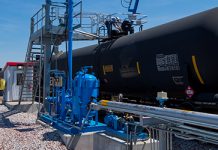Jim Lane
It towers above the surrounding Iowa countryside like the Launch Assembly Building lords it over Cape Canaveral it’s the new DuPont (DD) cellulosic ethanol project, on the outskirts of the town of Nevada.
Functional yet inspiring, imposing yet accessible when it opens before year end 2014 it is sure to be a monumental addition to the cellulosic biofuels landscape.
Last week we wrote:
“There are strategic reasons to develop this new industrial bioscience business in central Iowa not just the “we’d love to have you, wages are low, cost of living’s cheap, and no unions” factors that are of genuine appeal to companies but pertain to Mumbai and Shenyang, too.
That’s not to say that there’s no competition for Nevada. There’s corn stover a-plenty in the Midwest and many towns and industrial parks rail spurs, power, water, skilled labor and local growers. Blair (NE), Eddyville, Fort Dodge, Clinton, Hugoton (NE), just to name a few.
But once built, they’ll stay, so long as the economics of the product stay sound, And the more infrastructure you build, the more that is there for the next business to tap into. So these little Metropoli have every reason to hope for growth and for higher-skill, higher-wage positions to continue to appear, and not to disappear.”

The biomass intake system still with a few construction workers in view that will accept the corn stover and crush it down to a relatively fine powder there’s some chopping involved, and some hammering, to get the desired consistency for the enzymatic hydrolysis.

This unit above looks like the first stage of the Saturn V rocket, but it’s really almost a silo holding biomass after intake. After this unit, it will proceed left to the core hydrolysis technology where proprietary enzymes will separate out the C5 and C6 sugars

The units above include the large hydrolysis unit to the rear, and the fermentation units three of them, in the front. It’s bacterial fermentation, so that’s a change of pace from the more-traditional yeast.

Here, you see most of the same technology and some storage, from a different angle, but you also note there’s still a lively construction crew on site, pushing the project towards completion. That’s Fagen so well known during the first-generation of ethanol construction.

Distillation comes last, where the ethanol is separated from the “beer”.

Here. you can see the official bird of cellulosic biofuels the crane spotted all over Iowa and spreading into Kansas of late.
Jim Lane is editor and publisher of Biofuels Digest where this article was originally published. Biofuels Digest is the most widely read Biofuels daily read by 14,000+ organizations. Subscribe here.








